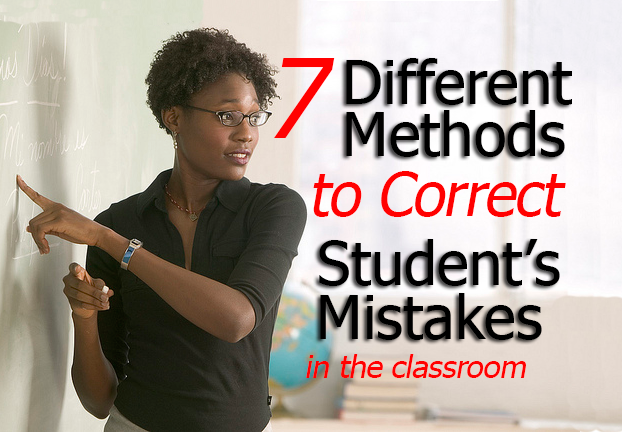Teaching students to self correct can give them many benefits and it is well worth the time to teach them to do so. It will help them be less reliable on a teacher and better prepare them for real life English language exchanges. Not to mention how much better it is for their confidence if they can correct themselves rather than being singled out in class for making that error. Finally it helps them take more responsibility for their learning and pay attention to their speaking rather than just spewing out random thoughts and words to express themselves.
So then, how to have students self correct their mistakes?
Alas it is easier said than done most teachers will say. Well here is a handy list of techniques that you can start to train your students (with repetition of course) on how to and when to self correct themselves.
While Students Are Speaking – Without Interrupting Them
#01. Connecting certain body language to mean certain things.
- You can start to teach your students a “Code Book” of body language. When they say “Yesterday I go shopping.” You can point backwards over your shoulder, this will signal a past tense verb should be used.
- Make sure you use the gestures consistently and tell the students what each gesture means when you start using it.
- Be sure to give them a thumbs up gesture once they have successfully self corrected the error to make it easy for them to move on and keep speaking.
#02. Use certain facial expressions.
- Showing shock with an open mouth and wide eyes can alert a student that what they have said is strange or does not make sense due to an error.
- Raising an eyebrow can alert them that they have missed something.
#03. Use visual reminders.
- Put up a poster of a big “s” and point to it every time they make a 3’rd person verb mistake or forget to use the plural form of a noun.
- Draw “S V O” on the whiteboard to symbolize the subject/verb/object of a sentence and point to the one where the error was made.
#04. Give them a yellow or red card.
- Just like in soccer (or football) hold up a yellow card if students make a mistake.
- If they repeat the same kind of mistake or make a very basic mistake you have covered many times give them the red card.
- Either card they get should alert them a mistake has been made.
Briefly Pausing Students While They Speak
#05. Ask a quick question.
- Try saying “What was that?”, “Sorry?”,”Can you repeat that?” to prompt them to find the error they just made.
#06. Echo the sentence the student said containing the error.
- Repeat the sentence and add stress to it when you get to the mistake.
- Or just repeat the sentence up to and stop when you get to the mistake.
- Finally repeat the sentence and in place of the mistake leave a verbal sound like “mmmm” or leave a brief pause taking out the mistake.
#07. Point out the mistake by using a prompt word.
- You can simply say “tense”, “plural”, “preposition” to point out what kind of category the mistake made was in.
- Also repeat the word they made in error and say “noun”, “verb”, “adjective” if it was in the wrong form.
#08. Use the white board to illustrate the mistake.
- Write the sentence on the board and circle the mistake or leave the mistake as a blank space.
- Also simply write the correct word to be used on the white board and let the student go back and repeat the sentence inserting the correction.
Using a variety of methods will help you communicate more without having to correct your students with long pauses and too much teacher talking time. How to have students self correct their mistakes isn’t that hard with a little practice. Try it! Your students confidence in their abilities will increase, your classes will run smoother, and your students will get a lot more talking time. Self correction? Who knew it could be so easy.







Great and useful post! It has always been one of the questions on my mind: “What’s the best way to correct a student without making them feel embarrassed or frustrated?” Well, the best way is for them to correct their own mistakes! It’s funny how you end up creating your private error-correction body language with your students, and you understand each other without words 🙂
Yes Gosia you are totally right about building up your own private body language with students. To think further into the topic I often ask myself “What even needs to be corrected?” When you think of fluency vs. accuracy it’s a good question to think about when you want to avoid stifling a student with too much correction. Read more here if you like: http://yourenglishsource.com/error-correction-in-esl-classroom/
—- What are some of your best gestures? I like using pointing behind me and in front of me for verb tense errors (past/future).
Since I mostly teach exam preparation classes, towards the end of the course accuracy tends to take over fluency and the amount of correction increases. When correcting glaring pronunciation errors I often simply touch my ear as if I misheard what my students had said. Another gesture I use a lot is rotating my index fingers letting my students know they should keep talking (it’s not a mistake as such, but stopping before one’s turn is over during an exam might cost them several points), and of course there is the tried and true waving back over my shoulder to let them know something isn’t right when they use reported speech (tense, tense, tense!). I used to squint a lot until one my students actually told me it was making them nervous, so now I try to stay clear of exaggerated facial expressions!